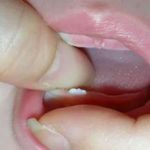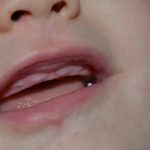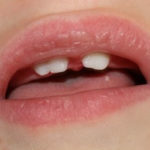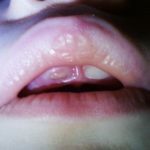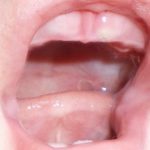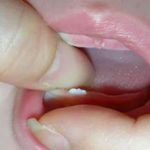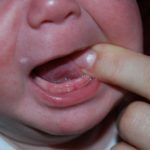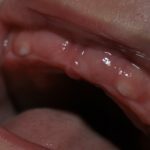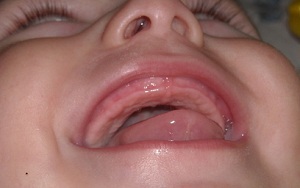 Parents of babies always with excitement expect an approach of the moment when at their adored child first teeth will be cut.
Parents of babies always with excitement expect an approach of the moment when at their adored child first teeth will be cut.
The greatest amount of trouble can deliver to all members of the family the eruption of the upper( especially the eye) teeth.
The process is different in each case. Admissible are considered minor deviations from the standard terms and the order in which the teeth are climbing, which should not cause serious concern.
Contents
- The timing of the appearance of the upper teeth
- How does the birth of a new tooth look like?
- Help and care for a child
- Why do teeth get so painful?
The timing of the appearance of the upper teeth
The process of the appearance of the upper teeth begins at 6-12 months and the eruption ends at the age of 2-3 years. At first, the formation of the central and lateral incisors is noted, followed by the cutting of the upper canines and molars.
The timing of the cutting of the upper and lower teeth( incisors, canines and molars) is as follows:
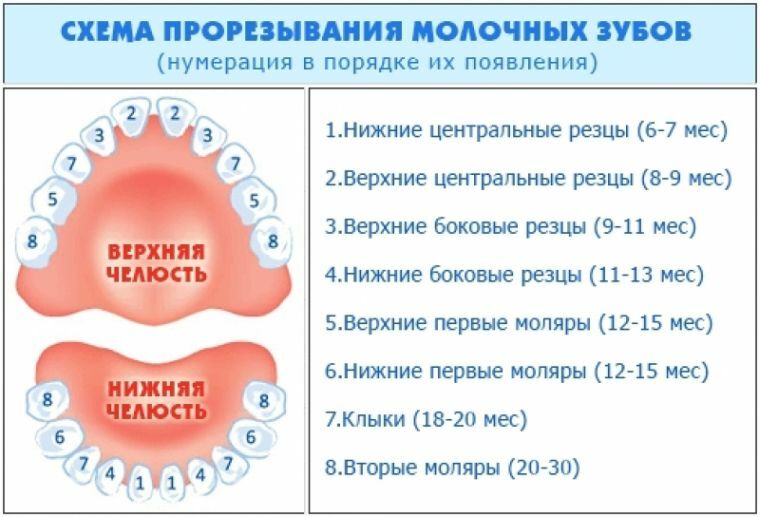
One tooth can climb for 2 days or a whole month. In some cases, the upper and lower teeth are cut at the same time, the whole process is accompanied by a pronounced symptomatology. Babies can change beyond recognition, become excessively irritable and whiny. Such a period of development of the child will require the parents maximum patience and calmness.
Correct and timely formation of teeth indicates a healthy state of the body. In some cases, later eruptions are noted. Significant delay can be observed due to prematurity, rickets, violations of the endocrine system, malnutrition. This situation is fraught with digestive disorders and untimely development of the baby's organs.
In order to normalize the process, it is recommended to introduce vitamin D preventive doses into the baby's diet, increase the number of calcium-containing foods( cheese, cottage cheese, milk) in the nursing mother's menu.
What does the birth of a new tooth look like?
It is important for parents to remember that the features of the appearance of teeth in children are largely determined by heredity. Each child has a separate process.
In pediatrics, several of the most common symptoms of the rapid eruption of new teeth are distinguished( in most cases, the upper ones climb more painfully and painfully):

In the photo, the characteristic appearance of the upper gums, when the incisors of the
- cut through the soreness in the oral cavity, often the causeuninterrupted whine;
- abundant salivation, leading to the flow of saliva from the mouth and redness on the skin of the baby;
- liquid stool, normally not exceeding 3-4 repetitions within 24 hours;
- cough caused by a lot of saliva;
- exacerbation of the sucking reflex, attempts to bite, gnaw various objects;
- vomiting, loss of appetite and fever( up to 38.5 ° C);
- pain in the ears.
The process of teething is inclined to activate at night, which causes restless sleep and children's "chants".
 Atypical behavior of the child causes confusion and anxiety among the people. With an independent examination of the mouth, you can find reddened swollen gums and small bruises.
Atypical behavior of the child causes confusion and anxiety among the people. With an independent examination of the mouth, you can find reddened swollen gums and small bruises.
Complications can become SARS, bronchitis, intestinal diseases, irritation in various parts of the body. Many of them are the body's response to the weakening of the immune system.
Photo - a compilation of the appearance of the gums of children during the period of teething of the upper teeth:
Help and care for a child
The baby's well-being during the eruption of the upper teeth requires the closest attention from adults. All family members need to carefully observe the cleanliness of the room, carry out the processing of children's dishes and toys, monitor the hygiene of the crumbs.
The order in the house is very important. When dust and dirt get into the baby's mouth, the inflammatory process starts to develop rather quickly.
Pediatricians offer modern tools designed to alleviate the condition of babies. These are:
- preparations containing Paracetamol( Efferalgan, Kalpol, Panadol), used when the child reaches 3 months;
- preparations of Ibuprofen, among which Nurofen is very popular;
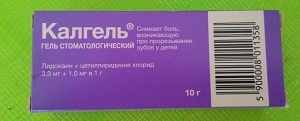
- Calgel, intended for treatment of the oral cavity from 5 months;
- Holisal in the form of a gel, used topically to relieve pain in children older than 1 year;
- Viburcoll in the form of suppositories, which contains only natural components.
To ease the child's condition, parents will need to surround him with lots of caress and care. When breastfeeding it is necessary to give the baby a breast at first request. This can distract him from constant discomfort and painful sensations.
Breastfeeding in this difficult period is desirable for soft food( baby purees, cereals, yoghurts), since solid foods can significantly injure sensitive gum areas.
Additional ways to soften the process can become:
- toys-teethers made of silicone or plastic;
- special tooth rings;
- finger massage of gums using special brushes;
- applying cold.
Beneficial can bring a raw peeled carrot, chilled cucumber or a banana. Use them only under the supervision of adults.
 During the period when the upper canines and incisors( the most painful and unpleasant for the baby) climb, one should refrain from introducing new foods into the diet, as well as visiting places of large concentrations of people. Many pediatricians recommend postponing the provision of preventive vaccinations for a while.
During the period when the upper canines and incisors( the most painful and unpleasant for the baby) climb, one should refrain from introducing new foods into the diet, as well as visiting places of large concentrations of people. Many pediatricians recommend postponing the provision of preventive vaccinations for a while.
After eruption special care for the oral cavity is required. Children under 2 years old can brush their teeth with a special baby brush. Closer to two years, it is recommended to use such preventive gels and pastes as the children's line "Weleda", "SPLAT Junior", foam "SPLAT Magic Foam".
With a competent approach, difficulties and discomfort can be minimized and significantly alleviate the condition of your beloved child.
Why do teeth get so painful?
For a child, each new tooth does not go unnoticed. The most difficult period is considered the formation of the first teeth, causing increased morbidity and irritability.
Such unpleasant sensations are associated with the peculiarities of each tooth manifestation - developing, it breaks through the gum, which causes pain and inflammation in it.
When breastfeeding or from a bottle, blood flows to inflamed and swollen gums, thereby exacerbating their sensitivity. The child feels a significant discomfort during eating, so can refuse to eat.
Similar sensations are new to babies, as a result they experience strong emotions. Self-selection of remedies may be unsuccessful. The best solution is to seek help from a pediatrician.
Teething is a natural and inevitable process, which largely affects the overall well-being of the child. Parents should know that the intensity of symptoms gradually weakens with each new tooth. In the future, eruption does not cause significant difficulties until the appearance of molars.

